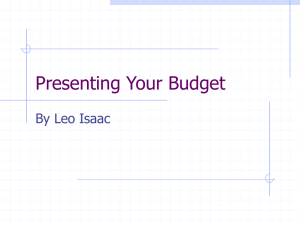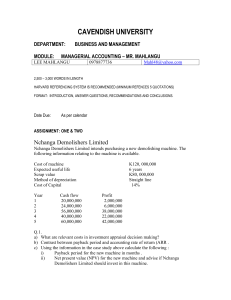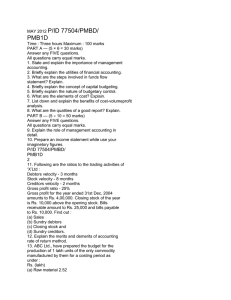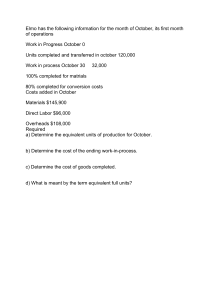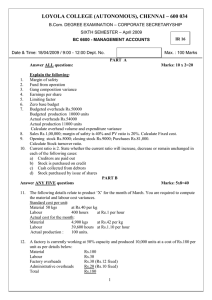FM june10 2010 jun a
advertisement
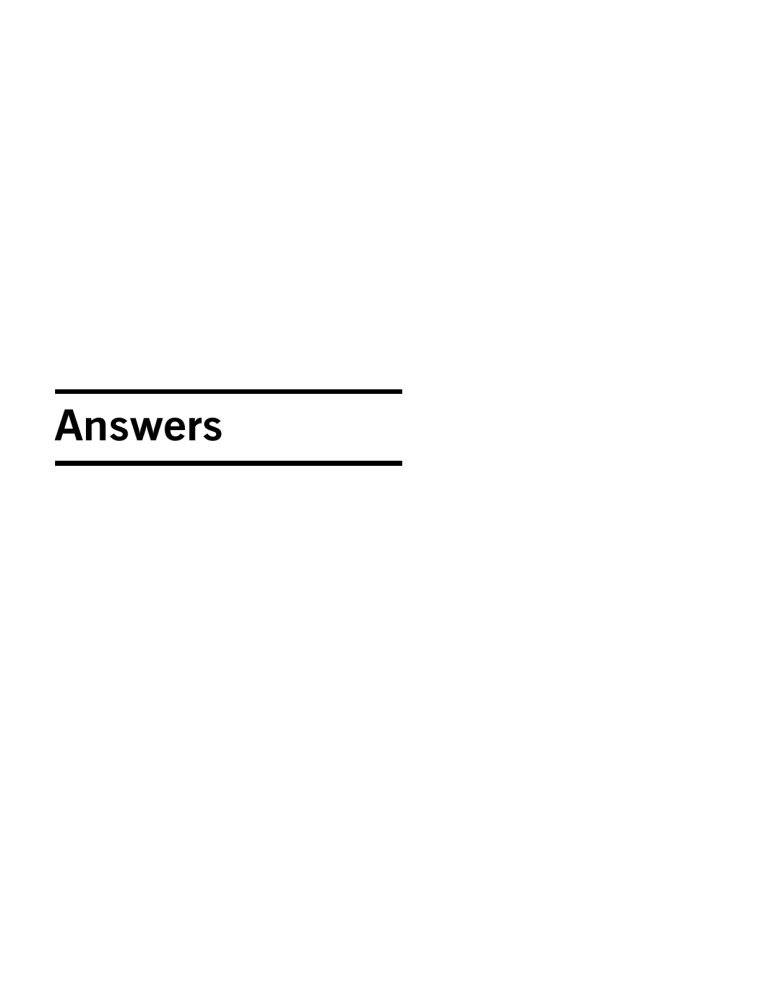
Answers ACCA Certified Accounting Technician Examination, Paper T10 Managing Finances June 2010 Answers Section A 1 D 2 A 100 100 – 1 1 1 + 99 365 / 23 – 1 = 17·3 % 365 / 23 – 1 = 17·3 % Candidates should answer it as above, therefore getting answer A. Otherwise, they will just try and guess it, in which case any of the answers is feasible! 3 Maximum inventory level = reorder level + reorder quantity – (min. usage x min. lead time) B Reorder level = max. usage x max. lead time = 1,000 x 10 = 10,000 kg. Max. inventory level = 10,000 + 1,000 – (300 x 5) = 11,000 – 1,500 = 9,500. Distractor A = 10 x 1,000 Distractor C = 5 x 300 Distractor D = A – C. 4 C 5 A Admin fee: $5,000,000 x 1% Cost of financing receivables $5,000,000 x 30/365 x 8% Total cost with factor Less cost before factor Net cost of factor $ 50,000 32,877 –––––––– 82,877 65,753 –––––––– –17,124 –––––––– –––––––– Distractor B: Candidate gets it wrong way round. Distractors C & D: Candidate only compares admin fee to cost without factor. 6 C Both statements are true. 7 D 8 B Only statement 2 is true. 9 A Interest yield = coupon rate/market price x 100% = 4/102·25 x 100% = 3·91% Distractor B: Candidate does not understand term interest yield and thinks it is same as coupon rate. Distractor C: is the redemption yield not the interest yield. Loss on redemption = $102·25 – $100 = $2·25. $2·25/102·25 = 2·2% Therefore, redemption yield = 3·91 – 2·2 = 1·71% Distractor D: is redemption LOSS as percentage (see above). 13 10 C a IRR = A + × (B – A) a– b Where A is the lower rate and B is the higher rate; a is the NPV at the lower rate and b is the NPV at the higher rate. 24,800 5% + –––––––– x (5%) 37,200 = approx. 8% Other distracters: feasible IRRs for candidates who haven’t learnt the formula! Section B 1 (a) Cash budget for the six months ended 31 December 2010. Jul Aug Sep Oct Nov $ $ $ $ $ Cash inflows (w.s1–3) Course fees – new customers – 19,200 19,200 28,800 19,200 – returning customers – 7,200 7,200 10,800 7,200 ––––––– ––––––– ––––––– ––––––– ––––––– Total cash inflows – 26,400 26,400 39,600 26,400 ––––––– ––––––– ––––––– ––––––– ––––––– Cash outflows Tutor costs (w.4) – 6,000 12,000 9,000 12,000 Staff costs (w.5) 1,000 4,000 4,200 4,200 4,200 Property costs (w.6) 6,000 Food costs (w.7) 1,100 – 1,200 1,224 1,872 General overheads (w.8) 2,585 1,185 1,185 1,185 1,185 Capital expenditure (w.9) 2,430 2,430 ––––––– ––––––– ––––––– ––––––– ––––––– Total cash outflows 4,685 13,615 24,585 18,039 19,257 ––––––– ––––––– ––––––– ––––––– ––––––– Net cash flow (4,685) 12,785 1,815 21,561 7,143 Cash b/f – (4,685) 8,100 9,915 31,476 ––––––– ––––––– ––––––– ––––––– ––––––– Cash c/f (4,685) 8,100 9,915 31,476 38,619 ––––––– ––––––– ––––––– ––––––– ––––––– ––––––– ––––––– ––––––– ––––––– ––––––– (b) Dec $ 28,800 10,800 ––––––– 39,600 ––––––– 12,000 4,200 6,300 3,216 1,185 ––––––– 26,901 ––––––– 12,699 38,619 ––––––– 51,318 ––––––– ––––––– Motives for holding cash The three motives for holding cash, as identified by Keynes, are: (i) The transactions motive. This means that a business holds cash in order to make the payments that are necessary to keep the business going, such as wages, taxes and payments to suppliers. If the business cannot meet its financial obligations as they arise, it may cease to be a going concern. It is therefore the main motive for holding cash. (ii) The precautionary motive. The second motive for holding cash is so that the business does not find itself in financial difficulties should some unforeseen expenses arise. In practice, businesses tend to cover themselves against this by arranging overdraft facilities with their banks. These do not cost businesses anything unless they are used. (iii) The speculative motive. This refers to businesses holding cash in case an opportunity to invest and earn money arises. Few businesses are likely to do this in practice as they will lose money whilst waiting for an opportunity to arise. Working 1: budgeted attendees No. of courses Prov. attendees Budgeted confirmed attendees per course Budgeted total attendees per month Jul – – Aug 2 16 Sep 4 8 Oct 3 16 Nov 4 8 Dec 4 12 – ––– – ––– 12 ––– 24 ––– 6 ––– 24 ––– 12 ––– 36 ––– 6 ––– 24 ––– 9 ––– 36 ––– Working 2: budgeted fees from full-priced customers Standard fees $ No. of attendees for month paying standard fee (2/3) Total full-priced fees $ Jul – Aug 1,200 Sep 1,200 Oct 1,200 Nov 1,200 Dec 1,200 – ––––––– – ––––––– 16 ––––––– 19,200 ––––––– 16 ––––––– 19,200 ––––––– 24 ––––––– 28,800 ––––––– 16 ––––––– 19,200 ––––––– 24 ––––––– 28,800 ––––––– 14 Working 3: budgeted fees from returning customers Fees with 25% reduction $ Jul Aug 900 – Sep 900 Oct 900 Nov 900 Dec 900 No. of attendees for month paying reduced fee (1/3) – 8 8 12 8 12 ––––––– ––––––– ––––––– ––––––– ––––––– ––––––– Total reduced price fees $ – 7,200 7,200 10,800 7,200 10,800 ––––––– ––––––– ––––––– ––––––– ––––––– ––––––– Working 4: Tutor Costs No. of courses Cost per course $ Jul Aug 2 3,000 Sep Oct Nov Dec – – 4 3,000 3 3,000 4 3,000 4 3,000 Cost of assistant (irrelevant – paid by Oliver James) $ Total cost per month $ – ––––––– – ––––––– 0 ––––––– 6,000 ––––––– 0 ––––––– 12,000 ––––––– 0 ––––––– 9,000 ––––––– 0 ––––––– 12,000 ––––––– 0 ––––––– 12,000 ––––––– Working 5: staff costs $ (Increase of 5% from September) ––––––– 1,000 ––––––– ––––––– 4,000 ––––––– ––––––– 4,200 ––––––– ––––––– 4,200 ––––––– ––––––– 4,200 ––––––– ––––––– 4,200 ––––––– Oct 36 52 1,872 ––––––– 1,224 ––––––– Nov 24 53 1,272 ––––––– 1,872 ––––––– Dec 36 54 1,944 ––––––– 3,216 ––––––– Working 6: Rental payments Current quarterly payments = $24,000/4 = $6,000 per annum. From December, annual rent = $24,000 x 1·05 = $25,200. Therefore, quarterly rent = $6,300 in December. Working 7: food costs Budgeted attendees (w.1) Food cost per head $ Total food cost per month $ Payable one month later $ Jul – – – ––––––– 1,100 ––––––– Aug 24 50 1,200 ––––––– – ––––––– Sep 24 51 1,224 ––––––– 1,200 ––––––– Working 8: General overheads Business rates = $8,350/10 = $835 for each of the six months. Fuel = $4,200/12 = $350 per month. In July, = $350 + (4 x $350) = $1,750. Total = $2,585 for July. $1,185 for each month August to December inclusive. Working 9: Capital expenditure Total cost = 3 x (1,800 x 90%) = $4,860. Half = $2,430 – payable in August and October. 15 2 (a) Working capital requirements: Current assets: $ Raw materials (8/52 x $13m) Finished goods: – raw material element (6/52 x $13m) 1,500,000 – labour element (6/52 x $16·25m) 1,875,000 – variable overhead element (6/52 x $9·75m) 1,125,000 –––––––––– WIP: – raw material element (2/52 x $13m x 75%) 375,000 – labour element (2/52 x $16·25m x 50%) 312,500 – variable overhead element (2/52 x $9·75m x 50%) 187,500 –––––––––– Accounts receivable (9/52 x $65m) Total current assets 875,000 11,250,000 ––––––––––– 18,625,000 (4,687,500) ––––––––––– 13,937,500 ––––––––––– ––––––––––– Working 1: Annual costs Turnover: $65,000,000 Direct materials $65m x 20% Direct labour $65m x 25% Variable overheads $65m x 15% Fixed overheads $65m x 18% Selling and distribution costs $65m x 5% (b) 4,500,000 Less current liabilities: Accounts payables: Direct materials (6/52 x $13m) (1,500,000) Direct labour (1/52 x $16·25m) (312,500) Variable overheads (8/52 x $9·75m) (1,500,000) Fixed overheads (5/52 x $11·7m) (1,125,000) Selling and distribution (4/52 x $3·25) (250,000) –––––––––– Working capital requirement $ 2,000,000 $ 13,000,000 16,250,000 9,750,000 11,700,000 3,250,000 Factors to take into account before lending The character of the borrower Since Bulb Co is a company, the bank will need to assess the experience and integrity of the directors of Bulb Co. In order to do this, the bank is likely to require a personal interview with at least some of the directors of Bulb Co. The bank will also assess integrity by reading the financial press and searching the internet for any signs of any disputes between the company or its directors with any other companies, organisations or individuals. The ability to borrow and repay The bank wants to be sure that Bulb Co will be in a position to repay the money. This assessment of the ability to repay will include an assessment of the company’s key ratios, in order to ascertain its financial health. The fact that Bulb Co has been making losses for the two years ended 20 November 2009 and 30 November 2008 will be a cause for concern for the bank. However, given the financial climate that the company has been working in, these losses will not be surprising. The bank will also look at the increase in sales that has taken place over the last six months, which is an indicator that the company is recovering. In considering the company’s ability to repay, the bank will take into account the fact that Bulb Co does not currently have any outstanding debt. Also, the bank may check whether the company has the authority to borrow the funds it is requesting. The company’s articles of association provide this information. The margin of profits The bank lends money in order to make money. It needs to ensure that it makes enough of a profit to warrant the risk that it takes by lending. Therefore, it will only lend money to Bulb Co if it can make a return that warrants the risk of lending. Most banks have lending policies which require them to charge different interest rates to customers depending on the reason for the borrowing. This is because some types of lending are more risky than others, therefore higher interest rate reflects higher risk. The bank may want to take some form of security for the lending, probably over the company’s property. 16 Purpose of the borrowing The purpose of the borrowing affects not only the interest rate but also the bank’s decision as to whether or not to lend in the first place. It will normally lend in order to finance working capital, provided that the company’s liquidity position is still manageable. The bank will carry out some financial analysis, looking at Bulb Co’s key ratios, in order to assess this. Amount of the borrowing Firstly, the bank will need to make sure that Bulb Co is not asking for more money than it needs for the purpose specified. If it is, this casts doubt over its ability to repay. Secondly, the bank needs to be sure that Bulb Co is asking for enough money. If it is not, the bank may well end up having to lend more in order to safeguard the original loan. Repayment terms Banks will pay close attention to the repayment terms when considering granting a loan. Obviously, being sure that a borrower will repay is critical and a bank should not lend money just because the borrower has security for the loan. Taking ownership of and selling any of the borrower’s assets would be a cumbersome process and is really a last resort. Payment terms need to be clearly agreed, documented and realistic, given the borrower’s financial position. Insurance The bank will need to be satisfied that Bulb Co’s business is adequately insured. An underinsured business can be disastrous. In addition, Bulb Co may wish to obtain payment protection insurance just to make sure that it can meet all of its loan repayments. Having said that, the bank must be satisfied that this is the case, without relying on any payment protection plan taken out by the company. NOTE: Only four factors were required. 3 (a) ARR and payback (a) Current methods Accounting rate of return (ARR) ARR measures the project’s annual average profit against the project’s annual average investment, expressed as a percentage. It is calculated by reference to the formula: average annual profits ––––––––––––––––––– x 100% average investment Payback period (PP) Payback period assesses how long it will take for the initial outlay on the equipment to be recouped, in cash terms. Cash flows are deemed to accrue evenly over each year. Calculations (b) ARR Increased revenues (5 x $5m) Less increased costs (5 x [1,500 + 1,000]) Profit before depreciation Less depreciation ($8m – 0·5m) Profit after depreciation Average annual profits ($5m/5) Average investment = (initial investment + residual value)/2 = ($8,000,000 + $500,000)/2 = $4,250,000 Therefore, ARR = 1,000,000/4,250,000 = 23·53% 17 $’000 25,000 –12,500 –––––––– 12,500 –7,500 –––––––– 5,000 1,000 (b) Payback period Initial outlay Year 1 Year 2 Year 3 Year 4 Year 5 Cash flow $’000 –8,000 2,500 2,500 2,500 2,500 2,500 Cumulative cash flow $’000 –8,000 –5,500 –3,000 –500 2,000 4,500 Payback occurs 500/2,500 through year 4 i.e. After 3·2 years. Since the hospital has a minimum ARR of 20% and a minimum PP of 4 years and this project has an ARR of 23·53% and a PP of 3·2 years, using these methods of appraisal, the investment should proceed. (c) Disadvantages Disadvantages of ARR – – – – NOTE: Only TWO disadvantages were required. Disadvantages of payback period – – – NOTE: Only TWO disadvantages were required. (d) Ignores time value of money Uses subjective ‘profits’ rather than cash flows Does not aim to maximise shareholder wealth Ignores how profits distributed over the period Ignores the time value of money. Ignores cash flows after the payback date. Does not take into account how cash flows are distributed during the payback period. NPV (i) The net present value of an investment is the sum of the present values of all future cash flows less the initial amount invested. The method therefore takes into account the timing of cash flows by taking future cash flows and discounting them to reflect the fact that, for example, $1 received in five years’ time is not worth the same as $1 received today. The discount rate used is the company’s cost of capital i.e. the rate it pays on keeping money tied up in the business. (ii) Calculations Time Cash flow D.F/A.F $’000 0 (8,000) 1 1–5 2,500 3·791 5 500 0·621 4 (a) Present value $’000 (8,000) 9,478 311 –––––––– 1,789 –––––––– The net present value of the project is $1·789 million. Since this is positive, the project should be undertaken. Current break-even point Fixed overheads = $35,000 x 12 months = $420,000. Sales price = $1,800,000/12,000,000 = $0·15 per photo. Contribution per unit = $0·15 – $0·11 = $0·04 per photo. Break-even point: Fixed costs ––––––––––––––––– Contribution per unit $420,000 = ––––––––– = 10,500,000 photos. $0·04 18 (b) New break-even sales revenue Direct materials $ – Paper 0·04 – Ink (0·3 x 90%) 0·027 –––––– Direct labour Variable overheads (0·02 x 70%) Variable cost per unit Selling price per unit Contribution per unit 0·067 0·01 0·014 –––––– 0·091 0·15 –––––– 0·059 –––––– –––––– Fixed overheads would increase by $60,000 (12 x $5,000) Therefore, the new break-even sales revenue is: Fixed costs ––––––––––––––––– x selling price Contribution per unit $420,000 + $60,000 = –––––––––––––––––––– x $0·15 = $1,220,339. $0·059 (c) Output level at which co would be indifferent The company would be indifferent about hiring the new machines where the total cost (fixed costs and variable costs) for production using the old machines is the same as total cost for production using the new machines. This can be calculated as follows: Increase in fixed costs/decrease in variable costs = $5,000 x 12/0·019 = 3,157,895. Answer can also be found by solving an equation, where ‘a’ = level of output. Total cost using old machines = ($35,000 x 12) + 0·11a Total Cost using new machines = ($40,000 x 12) + 0·091a Therefore: 420,000 + 0·11a = 480,000 + 0·091a 0·019a = 60,000 Therefore, a = 60,000/0·019 = 3,157,895. The co would be indifferent between which method was used if the number of good photos printed and sold was 3,157,895. (d) Marginal costing Advantages – – – – – – Note: Only three advantages were required. Disadvantages – – – – – Note: Only three disadvantages were required. It concentrates on controllable aspects of business by separating costs into their fixed and variable elements. Inventory valuations are not distorted with present year’s fixed costs. By its nature, it gives the most relevant costs to assist a decision-maker. Marginal costs are usually differential, incremental costs that are important for pricing decisions, or make or buy decisions or decisions involving a limiting factor. No adjustments need to be made for under/over absorption of overheads since these simply do not arise when using marginal costing techniques. It is simple to understand. It shows the relationship between cost, price and volume. It totally ignores fixed costs to products as if they are not important to production, which they are. Inventory valued using marginal costing is not an acceptable method for financial reporting purposes. It fails to recognise that, in the long run, most fixed costs become variable. Not all costs can be simply categorised as fixed or variable, since some costs have a fixed and variable element. In the long run, when making pricing decisions, fixed costs cannot be ignored since all costs must be covered if the business is to survive. 19 ACCA Certified Accounting Technician Examination, Paper T10 Managing Finances June 2010 Marking Scheme Section A Answers 1 to 10 2 marks per question Total Marks 2 ––– 20 ––– Answer 1 1 (a) Cash budget Budgeted attendees Budgeted fees – new Budgeted fees – returning Tutor costs (incl. ignore Mark) Staff costs Property costs Food costs General overheads Capital expenditure Net cash flow Cash b/f Cash c/f 2 2 2 1 2 1 2 2 1·5 0·5 0·5 0·5 ––– 17 ––– (b) Motives for holding cash 1 mark for each Total marks Overall total 1 ––– 3 ––– 20 ––– ––– 21 Marks 2 (a) Working capital requirements Calculation of costs (Wg 1): Direct materials Direct labour Variable overheads Fixed overheads Selling and distribution costs Calculation of current assets: Raw materials WIP Finished goods Receivables 0·5 0·5 0·5 0·5 0·5 ––– 2·5 ––– 0·5 3 1·5 1 ––– 6 ––– Calculation of current liabilities Accounts payable: Direct materials Direct labour Variable overheads Fixed overheads S&D Working capital required Total marks for (a) 0·5 0·5 0·5 0·5 0·5 ––– 2·5 ––– 1 ––– 12 ––– (b) Factors Each factor well described Overall total 2 ––– 8 ––– 20 ––– ––– 22 Marks 3 (a) ARR and PP Each definition 1 ––– 2 ––– (b) Calculations Calculation of average profits Calculation of average investment ARR Calculations of cash flows PP Recommendation 2 1 1 2 1 1 ––– 8 ––– (c) Disadvantages Per valid disadvantage Maximum marks 1 ––– 4 ––– (d) NPV (i) Explanation ––– 2 ––– (ii) NPV calculation Investment Revenues Residual value NPV and recommendation Overall total 1 1 1 1 ––– 4 ––– 20 ––– ––– 4 (a) Current B/E sales revenue Annual overheads Contribution BEP 1 1 1 ––– 3 ––– (b) New B/E sales revenue New contribution New overheads BE sales revenue 2 1 2 ––– 5 ––– (c) Indifference Explanation Calculation 2 4 ––– 6 ––– (d) Advantages and disadvantages Each advantage Max. marks 1 ––– 3 ––– Each disadvantage Max. marks Overall total 1 ––– 3 ––– 20 ––– ––– 23
